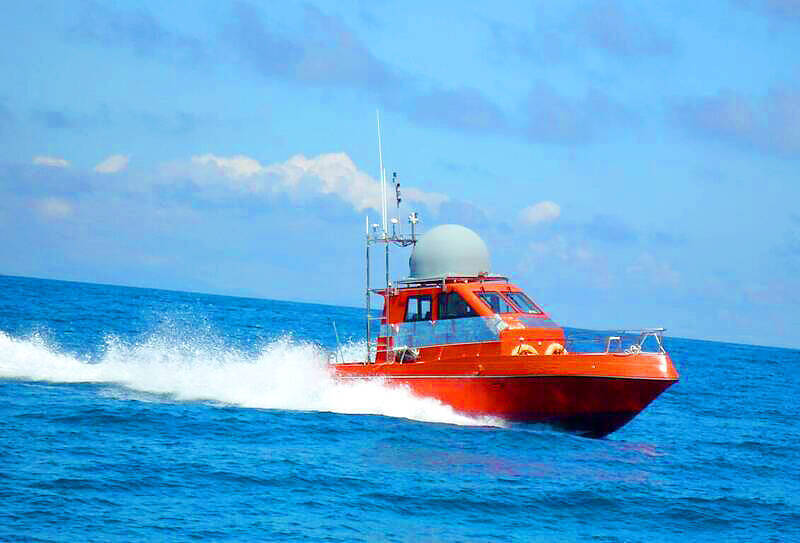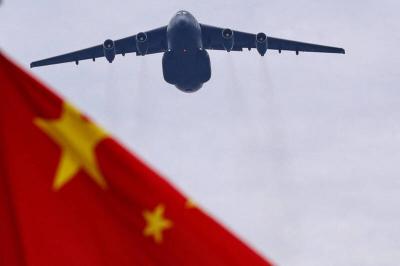The Ministry of National Defense is aiming to bolster the military arsenal by procuring four specific types of attack drones, a senior military official said on the condition of anonymity.
The drones include ones designed to execute short-range strikes, carry loitering munitions, take off and land vertically while changing flight attitude, and carry ammunition similar to a missile, but have extremely low costs.
Drones that can execute short-range strikes could launch direct attacks on the enemy, while those that are able to carry loitering munitions on board could carry out “suicide” attacks after locking in targets, the source said.

Photo: Screen grab from the institute’s Web site
The ministry has purchased four MQ-9B drones and 685 Switchblade 300 drones from the US. It also tasked the Chungshan Institute of Science and Technology (CSIST) to build Teng Yun (騰雲) drones and Chien Hsiang (劍翔) loitering munitions.
Meanwhile, the ministry tasked private contractors to build commercial drones for military use, which would enhance survivability and reconnaissance capabilities.
The CSIST is producing 200 second-generation Chien Hsiang drones, which can conduct cross-strait warfare with their ability to fly up to 1,000km. The Cat 1 loitering munition can be carried by individual soldiers, while Cat 2 can be installed on motor vehicles and ships.
Separately, the CSIST is scheduled to begin trials in June for uncrewed attack boats as part of the Kuachi Project (快奇專案), in which private contractors would be invited to participate, a source familiar with the matter said.
The project was launched to counter Chinese military expansion and “gray zone” harassment by enhancing asymmetric warfare capabilities. China has intensified its harassment against Taiwan, intending to exhaust the military and coast guard.
The project’s goal is to develop uncrewed attack boats that could carry explosives and be remotely controlled. The boats are scheduled to begin mass production next year, if they pass operational tests and evaluations by the end of this year. Private contractors such as Lungteh, Jong Shyn and CSBC would be invited to send their vessels for the trial, when the functions of the CSIST-produced uncrewed attack boats would be tested, the source said.
Results of the trial would affect subsequent research and development efforts, as well as mass production, they said.
In related news, the navy yesterday said that drills in waters southwest of Pingtung County scheduled for March 24 are “routine” exercises and would not involve live-fire training.
Local media had suggested that the exercises, which were announced by the navy on Thursday last week, could target an area in which alleged Chinese-owned ships flying flags of convenience have spent extended periods in recent days.
The coast guard should be able to “handle” the six vessels in waters around Taiwan, said Su Tzu-yun (蘇紫雲), research fellow and director of the Division of Defense Strategy and Resources at the Institute for National Defense and Security Research.
“The traditional division of labor between the coast guard and navy is based on a 24 nautical mile [44.4km] boundary,” Su said, adding that the coast guard controls waters within 24 nautical miles of Taiwan’s coastline, while the navy is responsible for the area beyond.
“However, when there are many targets and the frequency is high, the coast guard and navy support each other’s missions,” Su said.
The drills might be related to underwater infrastructure, including submarine telecommunications cables or power lines connecting offshore wind turbines, Su said.
Additional reporting by CNA

Beijing could eventually see a full amphibious invasion of Taiwan as the only "prudent" way to bring about unification, the US Department of Defense said in a newly released annual report to Congress. The Pentagon's "Annual Report to Congress: Military and Security Developments Involving the People's Republic of China 2025," was in many ways similar to last year’s report but reorganized the analysis of the options China has to take over Taiwan. Generally, according to the report, Chinese leaders view the People's Liberation Army's (PLA) capabilities for a Taiwan campaign as improving, but they remain uncertain about its readiness to successfully seize

Taiwan is getting a day off on Christmas for the first time in 25 years. The change comes after opposition parties passed a law earlier this year to add or restore five public holidays, including Constitution Day, which falls on today, Dec. 25. The day marks the 1947 adoption of the constitution of the Republic of China, as the government in Taipei is formally known. Back then the Chinese Nationalist Party (KMT) governed China from Nanjing. When the KMT, now an opposition party in Taiwan, passed the legislation on holidays, it said that they would help “commemorate the history of national development.” That

Taiwan has overtaken South Korea this year in per capita income for the first time in 23 years, IMF data showed. Per capita income is a nation’s GDP divided by the total population, used to compare average wealth levels across countries. Taiwan also beat Japan this year on per capita income, after surpassing it for the first time last year, US magazine Newsweek reported yesterday. Across Asia, Taiwan ranked fourth for per capita income at US$37,827 this year due to sustained economic growth, the report said. In the top three spots were Singapore, Macau and Hong Kong, it said. South

HORROR STORIES: One victim recounted not realizing they had been stabbed and seeing people bleeding, while another recalled breaking down in tears after fleeing A man on Friday died after he tried to fight the knife-wielding suspect who went on a stabbing spree near two of Taipei’s busiest metro stations, Taipei Mayor Chiang Wan-an (蔣萬安) said. The 57-year-old man, identified by his family name, Yu (余), encountered the suspect at Exit M7 of Taipei Main Station and immediately tried to stop him, but was fatally wounded and later died, Chiang said, calling the incident “heartbreaking.” Yu’s family would receive at least NT$5 million (US$158,584) in compensation through the Taipei Rapid Transit Corp’s (TRTC) insurance coverage, he said after convening an emergency security response meeting yesterday morning. National